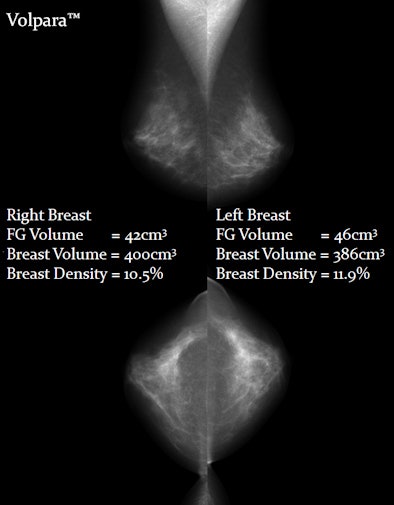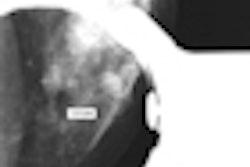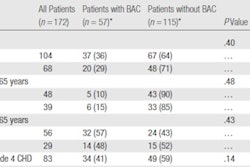
Breast tissue density is emerging as a major risk factor for breast cancer, but existing methods for measuring density can be cumbersome and depend on the skill of the operator. A New Zealand start-up company called Mātakina Technology hopes to change that and has enlisted an impressive array of clinical luminaries to help.
Recent clinical studies indicate that women with dense breast tissue have a higher risk for breast cancer -- for example, a clinical study published in Cancer in November 2009 found the risk to be as much as four times higher than for women with less-dense breasts. What's more, dense breast tissue can confound the accuracy of x-ray-based screening mammography.
Breast imagers have a number of tools at their disposal to use in women with dense breasts, such as ultrasound, MRI, and digital breast tomosynthesis. But when reviewing screening mammograms, when do you know you're dealing with a patient with dense breast tissue? Wouldn't it be great if a number grading tissue density just popped up on your mammography workstation?
That's the idea behind Volpara, a software application that Mātakina hopes to have on the market later in 2010. Volpara is designed to eliminate the guesswork and variability behind estimating breast density by using a consistent and automated method to produce a breast density measurement based on existing standards, according to Mātakina CEO Ralph Highnam.
Background in breast quantification
Highnam has been involved in the development of breast quantification software for years and received a Ph.D. in 1992 in the subject from the University of Oxford. Along with Professor Sir Michael Brady, he was involved in Mirada Solutions, a PET image fusion software developer that was spun out from Oxford and later acquired by CTI Molecular Imaging in 2003. (CTI itself was later purchased by Siemens Healthcare of Erlangen, Germany; Mirada has since been relaunched as Mirada Medical.)
After consulting for a few years following the CTI buyout, Highnam and Brady joined forces again, and at the 2008 RSNA meeting they met with noted breast researchers Dr. Martin Yaffe of Sunnybrook Health Sciences Center in Toronto and Nico Karssemeijer, Ph.D., of Radboud University Medical Center in Nijmegen, Netherlands.
The four discussed the need for tools that could measure breast density "reliably and robustly," Highnam said, and they decided to form Mātakina as the vehicle for bringing their ideas to market. Yaffe and Karssemeijer serve on the board of the company, while Brady is chairman.
The company set up shop in Wellington, where Highnam had settled following the CTI/Mirada buyout. Although New Zealand isn't usually thought of as a hotbed for technology start-ups, the country actually has access to top-flight engineering talent due to its role in developing special effects for films such as "The Lord of the Rings" and "Avatar," both of which were film in New Zealand.
The center of Mātakina's focus is Volpara. Highnam visualizes a workflow for the software in which a patient's completed digital mammogram will be processed by the Volpara algorithm before the image is read by a radiologist. Volpara will produce a measure of breast density, typically rendered in percentage terms from 0% to 30% (with average breast density around 10%).
Volpara measurements will automatically be output via DICOM structured reports, and density figures would appear on digital mammograms next to the images. Breast imagers could then use the calculations as an aid to their own visual interpretation of the images.
 |
| Volpara is being designed to place numerical values of breast density side by side on a patient's digital mammogram. Artist's rendition courtesy of Mātakina. |
Volpara's algorithm is based on a volumetric approach to breast density assessment, as opposed to the area-based methods used in previous algorithms for breast density measurement. Area-based measurements are more subjective and require more user training, the company believes.
For each analysis, Volpara uses a "relative" (as opposed to "absolute") physics model that doesn't require the calibration techniques necessary for previous volumetric analysis methods. Instead, the software focuses on an area of the breast that corresponds entirely to fatty tissue (typically along an edge of the breast that's not fully compressed) and uses it as a reference level to find the thickness of dense tissue at each pixel in the digital image.
The technique has been tested in nearly 2,500 mammograms acquired on full-field digital mammography units manufactured by GE Healthcare of Chalfont St. Giles, U.K., including images from some 400 women involved in the American College of Radiology Imaging Network's (ACRIN) Digital Mammographic Imaging Screening Trial (DMIST) performed at the University of Virginia in Charlottesville.
Results from those trials indicate that Volpara shows good agreement with both the ACR's BI-RADS scale for visually assessing breast density, as well as measurements made by Cumulus, a research-based breast density algorithm that uses an area-based method.
Path to market
Mātakina plans to submit a 510(k) application for Volpara to the U.S. Food and Drug Administration (FDA) in February; Highnam believes the company will steer clear of the regulatory issues that have ensnared developers of computer-aided detection (CAD) software because Volpara doesn't include an artificial intelligence component.
The company plans to start its commercialization efforts by placing the software at luminary breast centers in the U.S., but it also seeks relationships with distributors as well as mammography OEMs that might incorporate Volpara into their mammography reading workstation software. The company plans to begin placing systems in late summer to early fall of 2010.
Highnam believes that Volpara could some day help answer some of the thorny questions about who should receive mammography screening and how often -- questions that came into sharp relief after the U.S. Preventive Services Task Force (USPSTF) withdrew its recommendation that women ages 40 to 50 receive routine screening. Instead of a one-size-fits-all recommendation, screening intervals could be tuned to factors that include breast density.
"Volpara will be used in the future to optimize the screening pathway, with radiologists choosing modalities to do particularly difficult mammograms," Highnam said. "Maybe you assess risk with family history and density, and you screen those women [more often].
By Brian Casey
AuntMinnie.com staff writer
February 3, 2010
Related Reading
U.K. scientist wins medal, January 19, 2010
Copyright © 2010 AuntMinnie.com



















